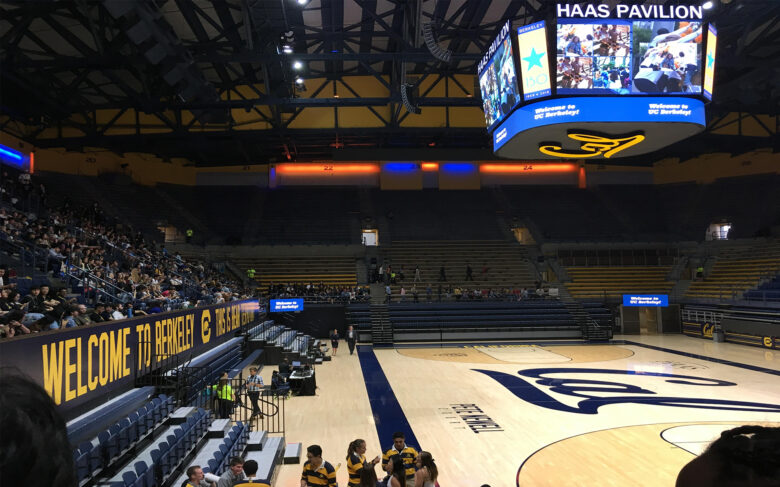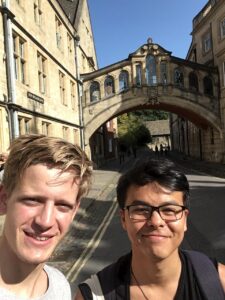Dear reader, this is for those of you who are interested in reading about why and how I got accepted to the exchange programme at UC Berkeley. It’ll be a long, but quite an instructive post for prospective applicants who want to familiarize themselves with the 6-month long applications process.
The idea of going to UC Berkeley for the exchange was planted in my head very early. I wouldn’t go as far as to say that it was a “dream”, but the goal of getting into the UC Berkeley exchange was definitely something that kept me going through many arduous study sessions over the course of more than a year. In fact, the thing that ultimately made me choose Lund over Uppsala university was the exchange programme with UC Berkeley. Needless to say, I was quite meticulous and, as opposed to most take-home essays and papers I had submitted up until that point, I put in my full effort into the application. And so, I became one out of 14 students from Lund who studied at UC Berkeley for a year.
Why did I want to go on an exchange to UC Berkeley?
In short, it was about wanting to challenge myself and to test my limits. I yearned for the opportunity to be in an environment surrounded by lots of smart and ambitious people. To meet likeminded people who enjoy the intellectual arm-wrestling of discussion and debate. To be able to hear world-leading economists lecture and ask them questions after class.
UC Berkeley (commonly referred to as “Cal”) is probably not as you imagine. At least it wasn’t exactly the way I imagined it.
It is not packed with violent left-wing activists shouting, so to speak. Nor is it more politically correct than in Lund. The most obvious difference lies in that people have a different lifestyle (i.e. American) and people are, on average, way more ambitious than at any university in Sweden (at least if you look at how much they study and associations they’re engaged in).
You’re reading this post because you want to know about the UC Berkeley exchange process so here goes. This post is divided into three sections (1) Lund University nomination, (2) University of California campus placement, and (3) post-admissions letter stuff.
Lund University nomination for the University of California exchange
The first part of the application was probably the most demanding. The University of California (UC) exchange is different from all other exchange programmes at Lund University. There is a separate application process for the UC exchange and there’s a person working full-time with it. Normally, either a faculty (e.g. faculty of science) or a department (e.g. department of mathematics) will have a partnership with some university faculty abroad. However, the UC exchange programme is centrally coordinated by Lund University. This means that you, as an applicant, compete with students from all faculties at Lund University (LU) to be one out of 85 students who is nominated by Lund university to the exchange. This nomination is necessary to even apply to any of the 10 UC campuses that are part of the programme.
You don’t need straight A’s to apply and get in. During the nomination stage of the process, applicants rank their exchange options by preference. I don’t know this for sure but I believe that the person reviewing the applications at Lund University will then nominate a limited number of students that have put UC Berkeley and UCLA as their first/second option. If you pick UC Santa Barbara and UC Irvine as your top two choices then I think that you’ll be in another “quota” so to speak. So while a UC Berkeley or UCLA exchange may require stellar grades (mostly top grades from high school and university), getting to some other UC campus does not. You compete with students applying for the same campus placement as yourself!
Let’s get to the fun part of getting a LU nomination. Paper work! (yay…)
- 1 Statement of Purpose
- 1 UC Campus Priority Sheet (rank your top three choices)
- 3 UC Study Plans (one for each of your three selected UC campuses)
- 1 CV/summary of previous experiences
- 1 LADOK transcript of your grades
My first piece of advice is to really really figure out why you want to go on this exchange (besides surfing every day, frat parties and Las Vegas). You should start writing your “Statement of Purpose” (SoP) early – something like 3 weeks before the deadline is probably good. Start with brainstorming. After that, write down three of the best reasons, one paragraph per reason, for why you want to go on the exchange. Your Statement of Purpose is very important and by writing a draft three weeks before the deadline, you have time to leave it, rewrite it and then send it on feedback rounds. I sent my SoP to three or four people who all gave advice and helped me improve my English. Remember that it is not a personal statement about who you are and what you’ve done but rather a statement that outlines your academic goals and interests while connecting both to the UC exchange and campus choice.
The second thing to note is that study plans do not really matter for but are still useful because they force you to do some research. Don’t spend too much time on it because it’s not going to matter when you actually get to pick courses later on. You can refer back to your course choices in your statement of purpose!
After the application was submitted there was a long wait. I still remember exactly where I was when I found out I got accepted to the University of California Education Abroad Program (UCEAP) as it is formally called. It was a Monday at the end of November that I was on the train to London after a weekend debating tournament at Cambridge and visiting my aunt and cousins. The extremely long email asked me to accept my nomination for the UC exchange as soon as possible and it contained instructions for the next part of the application. The part that would determine my campus placement.
University of California campus placement
This part of the application required the following documents and certificates:
- IELTS test score: International English Language Testing System. A compulsory exam that costs a little over SEK 1,000 to write. Lund University had a special sitting arranged for all students going to the UC exchange so there is no need to arrange for it in Malmö separately.
- Academic statement. A very short text of 1500 characters that explains why you want to enter the exact campus you want to enter.
- Certified high school diploma in English. In other words, an official, signed and / or stamped copy of your high school grades. I called my high school and they arranged it and mailed it to my dorm in Lund.
- University grades. Stamped and in English. Can be requested through LADOK.
- UC online application form. This is where you fill in personal information and course choices for each of your three campuses (basically using the information from the study plans above).
Tip number one. Practice English by hanging out with people who speak English. It will, in particular, help you get stellar results in the oral section of the IELTS (where you’ll sit with a native English speaker who’ll test your fluency and ability to discuss, explain and present arguments orally in English). The absolute most time-efficient way is probably to join the Lund Debate Society (LDS) – because it is up to you to reflect on abstract ideas in English and reason around them.
Tip number two. Think a lot about what really drives you. Why would you like to go to Campus X? In three paragraphs, I explained that my driving force was about developing our economic system towards sustainability and prosperity. Without growth, we would have a lot of problems with unemployment and probably the occasional financial crisis. But with growth, as it looks today, we just emit a lot of exhaust fumes through all the stuff we buy from China. Worst of all, these gadgets do not seem to have any effects on our self-perceived happiness – Sweden’s GDP has doubled since the 70’s, but it really does not have our happiness. This is a dilemma that is worth pondering.
Tip number three. Once you have been nominated, you will go to one of the UC campuses so don’t stress out about this application. You’ll be placed in a small group of seven people and the idea is that you all help each other gather the necessary documents. Collaborate as much as you can with those you are placed in a group with and send your text for feedback – then just relax! In addition, I think that Lund nominates students whom they believe have a good shot at getting placed at one of the campuses the applicant chose in the nomination application. It is worth mentioning that in this round you compete with exchange students from all over the world for places on the various campuses.
After receiving the admissions letter
After the English test was written and all the documents were submitted, it took 5 months before something happened. It was not until the first week of May that I was informed that I had been offered a place at UC Berkeley. Something that had been a possibility turned into a certainty. I had not been more excited or proud over myself over anything like that before. I remembering sitting in Delphi, L building, second floor, right hand side, kitchen sofa – opening the email, reading the words, and then closing my fist in a tacit celebration and end result of a 6-month long application process.
The last things to prepare…
Accommodation. Living “on-campus”, i.e. in a university dorm or at “International House” was ridiculously expensive (SEK 15,000 / month, food included, really shitty food tho). University dorms are mostly filled with freshmen and maybe some sophomores.
Insurance. Different requirements applied to different campuses. But for UC Berkeley, I was told that previous waves of exchange students all failed to convince UC Berkeley to recognize the “Kammarkollegiets utbytesförsäkring”… Not much to do than to simply pay up the $3000 that it would cost to be covered for 2 semesters at Cal.
Vaccine. UC requires a lot of vaccines. And you have to prove that you have taken them all or that you are immune (to chickenpox for example). Otherwise, you’ll have to take the vaccines. If there are a couple of expensive vaccines that you do not have then make sure you check if the mandatory health insurance (SHIP) covers it. I later discovered that my health insurance that I had to buy covered free vaccine (so I could have saved about SEK 1,000 on it).
Financial documentation. Also known as “show that you’ve got dem’ cash flow”. Prove that you will have/already have $15,000 available for the duration of the exchange. For this, it is required that you send in a form to CSN with an admission letter and then get back a letter stating how much you can get in student loans + grants. However, this is only enough for about $ 11,000. Therefore, further proof of funding is needed. You can either have someone who can be a sponsor (someone in the family, you know), or you show a fat-ass bank statement (go to the bank and they’ll help you with the paperwork).
Visa. Everything above is necessary for the issuance of your “DS-2019” which is required for the US student visa. Getting the visa requires an interview in Stockholm. Book an appointment early if you know you are away during the summer! It takes a week or so to get the actual visa once you’ve gone through the interview. Don’t worry about the interview. It went something like this: “Where are you going to study? What are you studying? Cool. Your visa is approved, next!”
Once all of this was done, and only then, I would be ready for the exchange year. Phew… I might write some post in the future if people are interested in it but you can find a pretty good summary of what I did on my Instagram. Also, feel free to reach out to me if you have some questions or want feedback on your statement of purpose – or just have a chat about life:)


